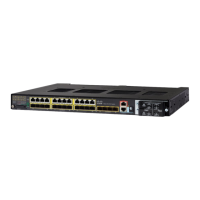861
Configuring IP Unicast Routing
Configuring BGP
In the following example, a prefix list is configured to permit routes from any network that have a mask length from 8 to
24 bits:
Switch(config)# ip prefix-list GREEN permit 0.0.0.0/0 ge 8 le 24
In the following example, a prefix list is configured to deny any route with any mask length from the 10.0.0.0/8 network:
Switch(config)# ip prefix-list ORANGE deny 10.0.0.0/8 le 32
Configuring BGP Community Filtering
One way that BGP controls the distribution of routing information based on the value of the COMMUNITIES attribute. A
community is a group of destinations that share some common attribute. Each destination can belong to multiple
communities. AS administrators can define to which communities a destination belongs. By default, all destinations
belong to the general Internet community. The community is identified by the COMMUNITIES attribute, an optional,
transitive, global attribute in the numerical range from 1 to 4294967200. These are some predefined, well-known
communities:
internet—Advertise this route to the Internet community. All routers belong to it.
no-export—Do not advertise this route to EBGP peers.
no-advertise—Do not advertise this route to any peer (internal or external).
local-as—Do not advertise this route to peers outside the local autonomous system.
Based on the community, you can control which routing information to accept, prefer, or distribute to other neighbors. A
BGP speaker can set, append, or modify the community of a route when learning, advertising, or redistributing routes.
When routes are aggregated, the resulting aggregate has a COMMUNITIES attribute that contains all communities from
all the initial routes.
You can use community lists to create groups of communities to use in a match clause of a route map. As with an access
list, a series of community lists can be created. Statements are checked until a match is found. As soon as one statement
is satisfied, the test is concluded.
To set the COMMUNITIES attribute and match clauses based on communities, see the match community-list and set
community route-map configuration commands in the Using Route Maps to Redistribute Routing Information, page 911.
By default, no COMMUNITIES attribute is sent to a neighbor. You can specify that the COMMUNITIES attribute be sent to
the neighbor at an IP address by using the neighbor send-community router configuration command.
BEFORE YOU BEGIN
Enable BGP routing as described in the Enabling BGP Routing, page 850.
